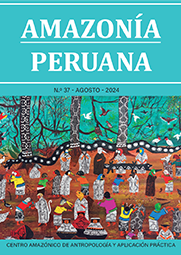Environment and actors in the cosmology of pano peoples: analysis of iskonawa, kakataibo and matsés accounts
DOI:
https://doi.org/10.52980/k9xf2a31Keywords:
environment, social actor, cosmology, Pano languages, Pano peopleAbstract
Amazonian peoples have created stories based on their perceptions that are passed down from generation to generation. Many of these stories narrate conceptions about the environment, animals and human beings. These con-ceptions are related to the cosmology of the people. The article aims to des-cribe the representation of the environment and its agents in the stories of the Pano, Iskonawa, Kakataibo and Matsés peoples; It also shows that there are several perspectives that show the agency or defiant behavior of foundational actors. For this purpose, one story is selected for each of the Pano peoples. The research concludes that in the stories the environment and its agents ful-fill specific roles and functions. It also points out that although there are ge-nerally harmonious foundational relationships, there are also those of war or predation. The work highlights the role of the transmitters of knowledge, such as the birds or the shaman.
Downloads
References
Alonzo, A. (2023). Análisis morfosintáctico de la transitividad en oraciones de un relato de la lengua asháninka. [Tesis de Maestría, Universidad Nacional Mayor de San Marcos]. Cybertesis. https://hdl.handle.net/20.500.12672/21678
Arias, G. (2024). Análisis semántico de los eventos de movimiento en iskonawa: aproximaciones a los patrones de lexicalización. [Tesis de Licenciatura, Universidad Nacional Mayor de San Marcos]. Cybertesis. https://hdl.handle.net/20.500.12672/24188
Bourdin, G.; Kindl, O. y Gutiérrez del Ángel, A. (2024). El perspectivismo: ¿una teoría desde el punto de vista de la alteridad? Encartes, 6(12), 211-225. http://portal.amelica.org/ameli/journal/370/3704645014/
Chavarría, M. (2019). De todas las sangres: las aves en la mitología amazónica. Pluriversidad, 4, 121-131. https://doi.org/10.31381/pluriversidad. v4i4.2774
Descola, P. (2004). Las cosmologías indígenas de la Amazonía. En P. García Hierro & A. Surrallés (eds.), Tierra adentro: Territorio indígena y percepción del entorno (pp. 25-36). IWGIA.
Descola, P. (2012). Más allá de naturaleza y cultura. Amorrortu.
Favaron, P. (2023). Netebo: aportes del perspectivismo shipibo-konibo a una reflexión filosófica indígena. Alpha, (56), 9-24. https://dx.doi.org/10.32735/s071822012023000563036
Favaron, P. y Haya de la Torre, J. (2023). La poética del territorio de Chonon Bensho. Interpretatio. Revista de Hermenéutica, 8(1), 21-57. https://doi.org/10.19130/irh.2023.1.021X54S0073
Finnegan, R. (1992). Oral Traditions and the Verbal Arts. A Guide to Research Practices. Routledge.
Fleck, D. (2003). A Grammar of Matses. [Tesis de doctorado, Rice University].
Fleck, D. (2008). Sugerencias metodológicas para realizar trabajo de cam¬po lingüístico en la Amazonía. Lexis, 32(2), 251-280. https://doi. org/10.18800/lexis.200802.003
Fleck, D., Uaquí, F. y Jiménez, D. (2012). Diccionario matsés – castellano. Con índice alfabético castellano – matsés e índice semántico castellano – matsés. Tierra Nueva. https://hdl.handle.net/20.500.12534/7JN5C4
González, S. (2015). Antropología y el estudio de las ontologías a princi¬pios del siglo XXI: sus problemáticas y desafíos para el análisis de la cultura. Estudios sobre las Culturas Contemporáneas, 21(42), 39-64. https://dialnet.unirioja.es/servlet/articulo?codigo=5278308
Guadarrama, P. y Martínez, R. (2023). Las cosmologías de los pueblos originarios sobre la Naturaleza y su influencia en el constitucionalismo. Novum Jus, 17(2), 171-191. https://doi.org/10.14718/NovumJus.2023.17.2.7
Lévi-Strauss, C. (1965). El totemismo en la actualidad. Fondo de Cultura Económico.
Lovón, M. (2019). El ‘ciudadano’ amazónico en el discurso oficial. Lingüística y Literatura, (75), 38-61. https://doi.org/10.17533/udea.lyl.n75a02
Martínez, I. (2007). Eduardo Viveiros de Castro: De imaginación, traducción y traición. Anales de Antropología, 41(2), 239-262.
Mazzotti, J. A., Zariquiey, R., y Rodríguez, C. (2018). Tradición oral iskonawa. Revista de Crítica Literaria Latinoamericana y Latinoamericana.
Ministerio de Cultura. (2017). Los pueblos shipibo-konibo, kakataibo e isconahua. Ministerio de Cultura.
Ministerio de Cultura. (s.f.). Base de Datos de Pueblos Indígenas u Origi¬narios. https://bdpi.cultura.gob.pe/
Ministerio de Educación. (2017). Relatos indígenas, andinos y amazóni¬cos. Ministerio de Educación.
Muyolema, A. (2002). La palabra desbordante. Cosmologías e historia en los relatos de tradición oral. En F. Garcés Velásquez & C. A. Muyo¬lema (eds.), Oralidades y escrituras kichwas (pp. 15-35). Editorial Abya-Yala. https://doi.org/10.7476/9789978108246
Prieto, A. (2015). Métrica de los cantos tradicionales kakataibo. [Tesis de licenciatura, Facultad de Letras y Ciencias Humanas, Pontificia Uni¬versidad Católica del Perú]. http://hdl.handle.net/20.500.12404/6636
Reniec (Registro Nacional de Identificación y Estado Civil) (2016). Tesoro de nombres matsés. https://bit.ly/4l4drf7
Rodríguez, C. (2015). Relaciones gramaticales en la lengua iskonawa. Lengua y Sociedad, 15(1), 45-58. https://doi.org/10.15381/lengsoc. v15i1.22592
Rodríguez, C. (2017). Prefijos de partes del cuerpo en iskonawa. LIAMES: Línguas Indígenas Americanas, 17(1), 117. https://doi.org/10.20396/liames.v17i1.8649166
Rodríguez, C. (2020). El retorno de la lengua iskonawa. Cadernos de Linguística, 1(3), 1–11. https://doi.org/10.25189/2675-4916.2020. v1.n3.id237
Santos, F. y Barclay, F. (Eds.). (1994). Guía etnográfica de la Alta Amazonía. FLASCO-Sede Ecuador IFEA.
Tournon, J. (2002). La merma mágica. Vida e historia de los shipibo-conibo del Ucayali. CAAAP.
Umaña Chiricente, B. (2021). Narrativa de los seres espirituales: cosmovisión y cultura asháninka. Amazonía Peruana, (34), 149–164. https://doi.org/10.52980/revistaamazonaperuana.vi34.270
Valenzuela, P. y Guillaume, A. (2017). Estudios sincrónicos y diacrónicos sobre lenguas pano y takana: una introducción. Amerindia, 39(1), 1-49. https://hal.science/hal-01920483v1
Viveiros de Castro, E. (1996a). Cosmological deixis and Amerindian Perspectivism. Journal of the Royal Anthropological Institute, 4, 469- 488. https://doi.org/10.2307/3034157
Viveiros de Castro, E. (1996b). Os pronomes cosmológicos e o perspectivismo ameríndio. Mana, 2(2), 115-144. https://doi.org/10.1590/S0104-93131996000200005
Viveiros de Castro, E. (2013). La mirada del jaguar. Introducción al perspectivismo amerindio. Entrevistas. Tinta Limón. https://tintalimon.com.ar/public/pdf_9789872739089.pdf
Zariquiey, R. (2011a). A grammar of Kashibo-Kakataibo. [Thesis Doctor of Philosophy, Faculty of Humanities and Social Sciences, La Trobe University]. https://doi.org/10.1515/9783110765816
Zariquiey, R. (2011b). Aproximación dialectológica a la lengua cashibo-cacataibo (pano). Lexis, 35(1), 5-46. https://doi.org/10.18800/lexis.201101.001
Zariquiey, R. (2015). Bosquejo gramatical de la lengua iskonawa. Latinoamericana Editores. http://www.etnolinguistica.org/article:vol6n1p81-83
Zariquiey, R. (2016). Vocabulario Iskonawa-Castellano-Inglés. Tufts University.
Zariquiey, R- y Fleck, D. (2013). Animales y plantas del pueblo kakataibo. Diccionario trilingüe (kakataibo, español, inglés) con identificaciones biológicas, índice alfabético castellano-kakataibo, clasificación semántica, nombres regionales y definiciones etnobiológicas. Lincom- Europa.
Downloads
Published
Issue
Section
License
Copyright (c) 2025 
Esta obra está bajo una Creative Commons Attribution 4.0 International License.

This work is licensed under a Creative Commons Attribution 4.0 International License.
















 Av. González Prada 626, Magdalena del Mar
Av. González Prada 626, Magdalena del Mar